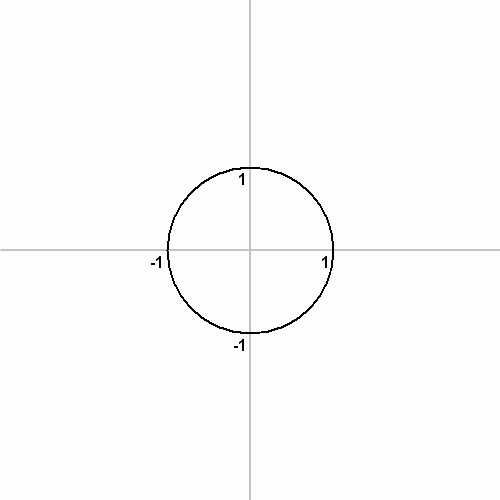Constructible polygon
In mathematics, a constructible polygon is a regular polygon that can be constructed with compass and straightedge. For example, a regular pentagon is constructible with compass and straightedge while a regular heptagon is not. There are infinitely many constructible polygons, but only 31 with an odd number of sides are known.

Conditions for constructibility


Some regular polygons are easy to construct with compass and straightedge; others are not. The ancient Greek mathematicians knew how to construct a regular polygon with 3, 4, or 5 sides,[1]:p. xi and they knew how to construct a regular polygon with double the number of sides of a given regular polygon.[1]:pp. 49–50 This led to the question being posed: is it possible to construct all regular polygons with compass and straightedge? If not, which n-gons (that is polygons with n edges) are constructible and which are not?
Carl Friedrich Gauss proved the constructibility of the regular 17-gon in 1796. Five years later, he developed the theory of Gaussian periods in his Disquisitiones Arithmeticae. This theory allowed him to formulate a sufficient condition for the constructibility of regular polygons. Gauss stated without proof that this condition was also necessary, but never published his proof. A full proof of necessity was given by Pierre Wantzel in 1837. The result is known as the Gauss–Wantzel theorem:
- A regular n-gon (that is, a polygon with n sides) can be constructed with compass and straightedge if and only if n is the product of a power of 2 and any number of distinct Fermat primes (including none).
(A Fermat prime is a prime number of the form )
In order to reduce a geometric problem to a problem of pure number theory, the proof uses the fact that a regular n-gon is constructible if and only if the cosine, , is a constructible number—that is, can be written in terms of the four basic arithmetic operations and the extraction of square roots. Equivalently, a regular n-gon is constructible if any root of the nth cyclotomic polynomial is constructible.
Detailed results by Gauss's theory
Restating the Gauss-Wantzel theorem:
- A regular n-gon is constructible with straightedge and compass if and only if n = 2kp1p2...pt where k and t are non-negative integers, and the pi's (when t > 0) are distinct Fermat primes.
The five known Fermat primes are:
Since there are 31 combinations of anywhere from one to five Fermat primes, there are 31 known constructible polygons with an odd number of sides.
The next twenty-eight Fermat numbers, F5 through F32, are known to be composite.[2]
Thus a regular n-gon is constructible if
- n = 3, 4, 5, 6, 8, 10, 12, 15, 16, 17, 20, 24, 30, 32, 34, 40, 48, 51, 60, 64, 68, 80, 85, 96, 102, 120, 128, 136, 160, 170, 192, 204, 240, 255, 256, 257, 272, 320, 340, 384, 408, 480, 510, 512, 514, 544, 640, 680, 768, 771, 816, 960, 1020, 1024, 1028, 1088, 1280, 1285, 1360, 1536, 1542, 1632, 1920, 2040, 2048, ... (sequence A003401 in the OEIS),
while a regular n-gon is not constructible with compass and straightedge if
- n = 7, 9, 11, 13, 14, 18, 19, 21, 22, 23, 25, 26, 27, 28, 29, 31, 33, 35, 36, 37, 38, 39, 41, 42, 43, 44, 45, 46, 47, 49, 50, 52, 53, 54, 55, 56, 57, 58, 59, 61, 62, 63, 65, 66, 67, 69, 70, 71, 72, 73, 74, 75, 76, 77, 78, 79, 81, 82, 83, 84, 86, 87, 88, 89, 90, 91, 92, 93, 94, 95, 97, 98, 99, 100, 101, 103, 104, 105, 106, 107, 108, 109, 110, 111, 112, 113, 114, 115, 116, 117, 118, 119, 121, 122, 123, 124, 125, 126, 127, ... (sequence A004169 in the OEIS).
Connection to Pascal's triangle
Since there are 5 known Fermat primes, we know of 31 numbers that are products of distinct Fermat primes, and hence 31 constructible odd-sided regular polygons. These are 3, 5, 15, 17, 51, 85, 255, 257, 771, 1285, 3855, 4369, 13107, 21845, 65535, 65537, 196611, 327685, 983055, 1114129, 3342387, 5570645, 16711935, 16843009, 50529027, 84215045, 252645135, 286331153, 858993459, 1431655765, 4294967295 (sequence A045544 in the OEIS). As John Conway commented in The Book of Numbers, these numbers, when written in binary, are equal to the first 32 rows of the modulo-2 Pascal's triangle, minus the top row, which corresponds to a monogon. (Because of this, the 1s in such a list form an approximation to the Sierpiński triangle.) This pattern breaks down after this, as the next Fermat number is composite (4294967297 = 641 × 6700417), so the following rows do not correspond to constructible polygons. It is unknown whether any more Fermat primes exist, and it is therefore unknown how many odd-sided constructible regular polygons exist. In general, if there are q Fermat primes, then there are 2q−1 odd-sided regular constructible polygons.
General theory
In the light of later work on Galois theory, the principles of these proofs have been clarified. It is straightforward to show from analytic geometry that constructible lengths must come from base lengths by the solution of some sequence of quadratic equations.[3] In terms of field theory, such lengths must be contained in a field extension generated by a tower of quadratic extensions. It follows that a field generated by constructions will always have degree over the base field that is a power of two.
In the specific case of a regular n-gon, the question reduces to the question of constructing a length
- cos 2π/n ,
which is a trigonometric number and hence an algebraic number. This number lies in the n-th cyclotomic field — and in fact in its real subfield, which is a totally real field and a rational vector space of dimension
- ½φ(n),
where φ(n) is Euler's totient function. Wantzel's result comes down to a calculation showing that φ(n) is a power of 2 precisely in the cases specified.
As for the construction of Gauss, when the Galois group is 2-group it follows that it has a sequence of subgroups of orders
- 1, 2, 4, 8, ...
that are nested, each in the next (a composition series, in group theory terms), something simple to prove by induction in this case of an abelian group. Therefore, there are subfields nested inside the cyclotomic field, each of degree 2 over the one before. Generators for each such field can be written down by Gaussian period theory. For example, for n = 17 there is a period that is a sum of eight roots of unity, one that is a sum of four roots of unity, and one that is the sum of two, which is
- cos 2π/17 .
Each of those is a root of a quadratic equation in terms of the one before. Moreover, these equations have real rather than complex roots, so in principle can be solved by geometric construction: this is because the work all goes on inside a totally real field.
In this way the result of Gauss can be understood in current terms; for actual calculation of the equations to be solved, the periods can be squared and compared with the 'lower' periods, in a quite feasible algorithm.
Compass and straightedge constructions
Compass and straightedge constructions are known for all known constructible polygons. If n = p·q with p = 2 or p and q coprime, an n-gon can be constructed from a p-gon and a q-gon.
- If p = 2, draw a q-gon and bisect one of its central angles. From this, a 2q-gon can be constructed.
- If p > 2, inscribe a p-gon and a q-gon in the same circle in such a way that they share a vertex. Because p and q are relatively prime, there exists integers a,b such that ap + bq = 1. Then 2aπ/q + 2bπ/p = 2π/pq. From this, a p·q-gon can be constructed.
Thus one only has to find a compass and straightedge construction for n-gons where n is a Fermat prime.
- The construction for an equilateral triangle is simple and has been known since Antiquity. See equilateral triangle.
- Constructions for the regular pentagon were described both by Euclid (Elements, ca 300 BC), and by Ptolemy (Almagest, ca AD 150). See pentagon.
- Although Gauss proved that the regular 17-gon is constructible, he did not actually show how to do it. The first construction is due to Erchinger, a few years after Gauss' work. See heptadecagon.
- The first explicit constructions of a regular 257-gon were given by Magnus Georg Paucker (1822)[4] and Friedrich Julius Richelot (1832).[5]
- A construction for a regular 65537-gon was first given by Johann Gustav Hermes (1894). The construction is very complex; Hermes spent 10 years completing the 200-page manuscript.[6]
Other constructions
The concept of constructibility as discussed in this article applies specifically to compass and straightedge construction. More constructions become possible if other tools are allowed. The so-called neusis constructions, for example, make use of a marked ruler. The constructions are a mathematical idealization and are assumed to be done exactly.
A regular polygon with n sides can be constructed with ruler, compass, and angle trisector if and only if where r, s, k ≥ 0 and where the pi are distinct Pierpont primes greater than 3 (primes of the form [7]:Thm. 2
See also
References
- Bold, Benjamin. Famous Problems of Geometry and How to Solve Them, Dover Publications, 1982 (orig. 1969).
- Fermat factoring status Archived 2016-02-10 at the Wayback Machine by Wilfrid Keller.
- Cox, David A. (2012), "Theorem 10.1.6", Galois Theory, Pure and Applied Mathematics (2nd ed.), John Wiley & Sons, p. 259, doi:10.1002/9781118218457, ISBN 978-1-118-07205-9.
- Magnus Georg Paucker (1822). "Geometrische Verzeichnung des regelmäßigen Siebzehn-Ecks und Zweyhundersiebenundfünfzig-Ecks in den Kreis". Jahresverhandlungen der Kurländischen Gesellschaft für Literatur und Kunst (in German). 2: 160–219.
- Friedrich Julius Richelot (1832). "De resolutione algebraica aequationis x257 = 1, sive de divisione circuli per bisectionem anguli septies repetitam in partes 257 inter se aequales commentatio coronata". Journal für die reine und angewandte Mathematik (in Latin). 9: 1–26, 146–161, 209–230, 337–358. doi:10.1515/crll.1832.9.337.
- Johann Gustav Hermes (1894). "Über die Teilung des Kreises in 65537 gleiche Teile". Nachrichten von der Gesellschaft der Wissenschaften zu Göttingen, Mathematisch-Physikalische Klasse (in German). Göttingen. 3: 170–186.
- Gleason, Andrew M. (March 1988). "Angle trisection, the heptagon, and the triskaidecagon". American Mathematical Monthly. 95 (3): 185–194. doi:10.2307/2323624.
External links
- Duane W. DeTemple (1991). "Carlyle Circles and the Lemoine Simplicity of Polygonal Constructions". The American Mathematical Monthly. 98 (2): 97–108. doi:10.2307/2323939. JSTOR 2323939. MR 1089454.
- Christian Gottlieb (1999). "The Simple and Straightforward Construction of the Regular 257-gon". Mathematical Intelligencer. 21 (1): 31–37. doi:10.1007/BF03024829. MR 1665155.
- Regular Polygon Formulas, Ask Dr. Math FAQ.
- Carl Schick: Weiche Primzahlen und das 257-Eck : eine analytische Lösung des 257-Ecks. Zürich : C. Schick, 2008. ISBN 978-3-9522917-1-9.
- 65537-gon, exact construction for the 1st side, using the Quadratrix of Hippias and GeoGebra as additional aids, with brief description (German)



